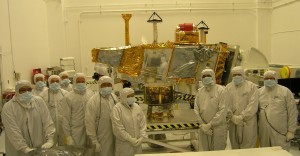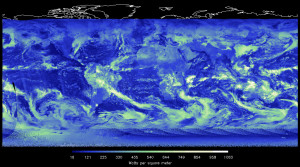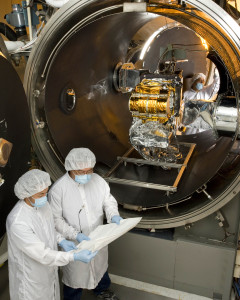On 28 October 2011, the NPP weather and climate satellite launched on a Delta II rocket from Vandenberg Air Force Base. Launches are complicated affairs and delays are routine. Not this one. The launch poll was unanimous, the countdown was smooth, and I had the good fortune to be able to witness the rocket ignite, climb, turn, and disappear into an unusually cloudless sky very very early in the California morning. It settled into a polar orbit about 512-miles over the earth’s surface and will continue collecting and relaying vital data for the foreseeable future.
NPP carried five instruments and I managed the team that delivered the sole climate sensor to the spacecraft. The CERES (Clouds and Earth’s Radiant Energy System) radiometer measures sunlight reflected from clouds and the earth’s surface along with infrared energy radiated by the warm earth itself. Science teams at NASA and around the world have been using data from CERES instruments to understand the effects of aerosols and clouds on the earth’s climate. CERES was not intended to be part of NPP but was manifested late to take advantage of an opportunity that presented itself. We were given a shade under nine months in 2008 to prepare the Flight Model 5 (FM5) instrument for the satellite including updating its innards, software, and performing extensive ground tests and calibrations. Our team delivered the unit a few days ahead of schedule. The instrument then waited for other sensors to arrive and the spacecraft underwent intensive testing before its ride to orbit. Following the launch, the mission was renamed Suomi-NPP in honor of Dr. Verner Suomi, one of the pioneers of space-based earth observation.
CERES instrument and team members (foreground) and the NPP spacecraft (background)
Photo courtesy Ball Aerospace Corporation
It typically takes months to fully commission a satellite as complex as Suomi-NPP once it is launched. Instruments are turned on one-by-one and carefully put through a well-planned and thoroughly rehearsed set of checkouts and tests by the mission operations team. CERES FM5 was not turned on until late January 2012. One of the ‘first-light’ CERES images from the NASA science teams is below. It shows the visible light from the sun scattered off of clouds and land.

Incoming solar energy reflected back into space by clouds
Image courtesy NASA/NOAA CERES Team via NASA Langley Research Center
There are now five CERES instruments in orbit. FM1 and FM2 launched on the Terra satellite in 1999, FM3 and FM4 launched on the Aqua satellite in 2002. The first four units are operating well beyond their five year design life and FM5 will preserve the continuity of a critical piece of earth’s climate data record.
